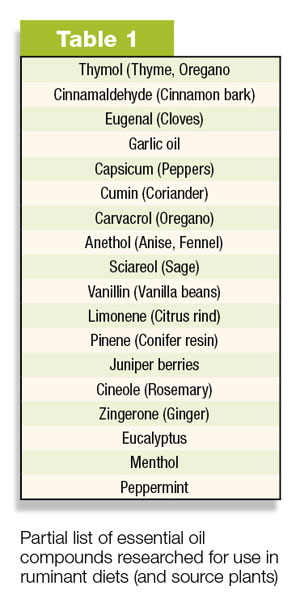In the realm of cattle production, that includes seeing value in practices or products that:
- Have a positive impact on rumen microbial activity
- Show a resulting increase in productivity and efficiency
- Have a positive impact on health and immunity
- Mitigate the environmental impacts of livestock production
One group of potential feed additives, broadly termed “essential oils,” may have the ability to positively affect all these measures. There is also interest in these compounds as possible replacements for (or enhancements to) antibiotics and ionophores.
Essential oils are volatile compounds extracted from specific plants or plant parts. Obtained via steam or solvent distillation, sometimes aided by enzymatic processes, their biologically active components include terpenes, phenylpropanes, isoflavones, diallyl disulfide and others.
They are “essential,” not to the animals we may feed them to, but to the plants themselves, as they help defend against disease, fungal and insect attacks.
These compounds are the basis of many of the medicinal and preservative uses of plants, which of course date back thousands of years. Focused research on their application in animal production has been going on since the 1970s, with a renewed emphasis due to recent concerns about antibiotic use in livestock.
Published studies have reported trials involving lactating and transition dairy cows, feedlot animals, developing heifers, beef cows and growing calves, lactating goats, wethers and a variety of in vitro (laboratory) procedures.

What do they do?
A wide range of traits have been tracked in various trials. Responses range from no difference to highly significant, but it is obvious that, at least under certain conditions, essential oils can impact all of the following:
- Microbial growth and fermentation
- Volatile Fatty Acid (VFA): total volume and relative proportions
- Microbial protein production: numbers and efficiency
- Methane production
- Rumen ammonia levels
- Rumen pH
- Dry matter intake and eating patterns
- Feed efficiency
- Milk production
- Milk components: marketable, MUN and SCC
- Carcass characteristics
- Digestibility: ruminal and total tract
- Immune status
How do they work?
Scientists seem to agree that the primary mode of action for these compounds is selective microbial inhibition. It is believed they interact with some cell membranes, inhibiting growth of the bacteria.
Some may also inhibit key enzyme systems, or be effective at reducing protozoa populations.
This leads to a reduced Acetate:Propionate ratio, less methane (which represents an energy loss), and reduced deamination and proteolysis (which represent protein loss).
At least some essential oils may also trigger changes in feeding behavior and in energy partitioning, as well as functioning as anti‐oxidants.
The variations seen in research to date may be due a number of variables, many of which have practical implications. Obviously, different compounds may have different activities and impacts, as may feeding just one versus a combination of extracts.
Dosage amount is certainly important, as it appears we could feed too little or too much to get a desirable result. And this is driven not just by feeding rate, but also the purity of the product being used.
Form of the additive – oil, powder, pellet, encapsulation – may also change how it acts in the rumen. And it is not yet clear how much effect the type of diet or class and stage of production of the animals has on key responses.
And in the real world?
A growing number of companies are developing and releasing essential oil‐based products. These may be complete plant extracts, containing multiple potentially‐active compounds – oil from oregano, for example, is reported to have about 35 – a purified compound or a specific combination.
In practice, a cattle producer should think through the following questions, and make a product use decision based on available research and product information.
- Does this compound, or combination of compounds, have a proven fit for my cattle and feeding
- program?
- Is the dosage based on active ingredients and calculated for the animals being fed?
- What is the potential for long‐term adaptation in the rumen leading to reduced efficacy?
- Is there any chance for residues or other impacts in marketed products (meat, milk)?
- Is there good reason to expect this to be a cost‐effective investment?
Every new opportunity for improving production, efficiency, sustainability or profitability deserves consideration. Time will tell if essential oils become an essential tool in our cattle feeding toolbox.
—From Quality Liquid Feeds newsletter







